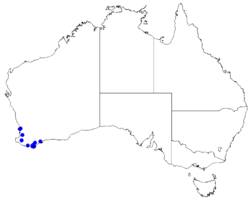Biology:Boronia crassipes
| Boronia crassipes | |
|---|---|
| Scientific classification | |
| Kingdom: | Plantae |
| Clade: | Tracheophytes |
| Clade: | Angiosperms |
| Clade: | Eudicots |
| Clade: | Rosids |
| Order: | Sapindales |
| Family: | Rutaceae |
| Genus: | Boronia |
| Species: | B. crassipes
|
| Binomial name | |
| Boronia crassipes Bartl.[1]
| |

| |
| Occurrence data from Australasian Virtual Herbarium | |
Boronia crassipes is a plant in the citrus family, Rutaceae and is endemic to the south-west of Western Australia. It is an erect, spindly, glabrous shrub with simple leaves, and pale red or pale mauve, four petalled flowers.
Description
Boronia crassipes is an erect, spindly shrub that grows to a height of about 0.5–3 m (2–10 ft). It has simple, linear to narrow elliptic leaves 10–15 mm (0.4–0.6 in) long. The flowers are arranged singly in leaf axils on a club-shaped pedicel about 6 mm (0.2 in) long. The four sepals are red, narrow triangular and 2–3 mm (0.08–0.1 in) long. The four petals are pale red or pale mauve, elliptic and about 7 mm (0.3 in) long. The eight stamens are about 2.5 mm (0.1 in) long a have a few soft hairs.[2][3][4]
Taxonomy and naming
Boronia crassipes was first formally described in 1845 by Friedrich Gottlieb Bartling and the description was published in Plantae Preissianae.[5][6] The specific epithet (crassipes) is derived from the Latin words crassus meaning "thick", "fat" or "stout"[7]:237 and pes meaning "a foot".[7]:600
Distribution and habitat
This boronia grows peaty heath, in winter-wet sawamps and along creeklines near Albany in the Jarrah Forest and Warren biogeographic regions.[2][3]
Conservation
Boronia crasspies is classified as "Priority Three" by the Government of Western Australia Department of Parks and Wildlife[3] meaning that it is poorly known and known from only a few locations but is not under imminent threat.[8]
References
- ↑ "Boronia crassipes". Australian Plant Census. https://biodiversity.org.au/nsl/services/apc-format/display/59689. Retrieved 6 March 2019.
- ↑ 2.0 2.1 Duretto, Marco F.; Wilson, Paul G.; Ladiges, Pauline Y.. "Boronia crassifolia". Australian Biological Resources Study, Department of the Environment and Energy, Canberra.. https://profiles.ala.org.au/opus/foa/profile/Boronia%20crassipes. Retrieved 6 March 2019.
- ↑ 3.0 3.1 3.2 "Boronia crassipes". FloraBase. Western Australian Government Department of Parks and Wildlife. https://florabase.dpaw.wa.gov.au/browse/profile/4412.
- ↑ Bentham, George; von Mueller, Ferdinand (1863). Flora Australiensis (Volume 1). London: Lovell Reeve and Co.. p. 322. https://www.biodiversitylibrary.org/item/3669#page/380/mode/1up. Retrieved 6 March 2019.
- ↑ "Boronia crassipes". APNI. https://id.biodiversity.org.au/instance/apni/464215. Retrieved 6 March 2019.
- ↑ Bartling, Friedrich Gottlieb (1845). Plantae Presiiianae. Hamburg. p. 168. https://www.biodiversitylibrary.org/item/9227#page/173/mode/1up. Retrieved 6 March 2019.
- ↑ 7.0 7.1 Brown, Roland Wilbur (1956). The Composition of Scientific Words. Washington, D.C.: Smithsonian Institution Press.
- ↑ "Conservation codes for Western Australian Flora and Fauna". Government of Western Australia Department of Parks and Wildlife. https://www.dpaw.wa.gov.au/images/documents/plants-animals/threatened-species/Listings/Conservation%20code%20definitions.pdf. Retrieved 6 March 2019.
Wikidata ☰ Q15388866 entry
 |


